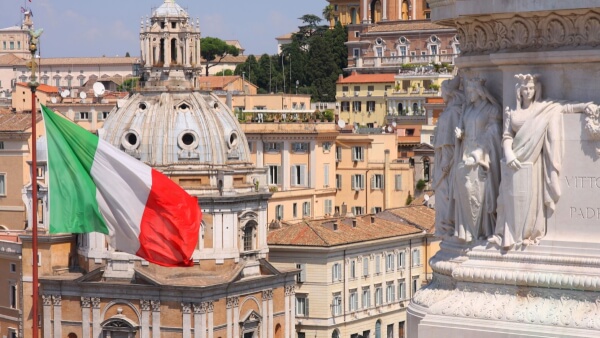Ski resorts in Italy: Best areas and resorts for Brits
Explore the best ski resorts in Italy for luxury escapes, family holidays and group getaways. Get tips for packing, dining, staying safe and saving money.

Travelling to Italy from the UK? Perhaps you’re planning a culture-packed city break in Rome, Venice or Florence or a sun-soaked holiday on the Amalfi Coast. Or you might be going there for work or business.
Whatever your reason for travelling, you’re going to need some spending money.
Below, we’ll give you the full lowdown on ATMs in Italy, in case you need euros in cash. This includes where to find ATMs, what they charge and everything else you need to know.
We’ll even show you a super convenient way to spend abroad using the Wise card, which works in 150+ countries.
So, let’s get started.
You can find ATMs in Italy on almost every block in major cities and in the main square in smaller towns and villages.
They’re also available in airports, shopping centres and in or outside banks. The country has a wide ATM network, so you shouldn’t have a problem finding one.
To find your nearest ATM in Italy, you can use these ATM locator tools from major Italian banks:
ATMs are generally called bancomat in Italy. Some may simply be marked with ‘ATM’, especially in tourist hotspots.
ATMs in Italy generally accept Visa and Mastercard debit and credit cards, which is good news as these are the most commonly issued cards in the UK. And they usually accept foreign cards as well as locally issued ones.
So, you should be fine to use your UK-issued card abroad - just make sure you check with your bank about any potential charges.
You can search for your nearest cash machine in Italy with these global ATM locators:
ATMs in Italy use and accept 4-digit PINs, which is compatible with UK-issued cards.2
When it comes to paying for goods and services in shops and restaurants, Chip and PIN and/or contactless payment technology is generally used.
However, you might still encounter some vendors using older systems which require the swiping of the magnetic stripe on your debit card.2 So, you’ll need to check if your card has this.
The maximum amount you can withdraw from an Italian ATM will largely depend on your bank. Each bank usually has its own daily, weekly and/or monthly withdrawal limits.
ATMs in Italy also tend to have withdrawal limits of between €250 to €1000 per transaction, although it may be possible to find ATMs without any set limit.2
It used to be the case that you had to let your bank know you’d be using your debit card abroad. Otherwise, your card wouldn’t work or your payments would be flagged up as fraud.
These days, it isn’t absolutely essential to do this - but you might want to quickly contact your bank anyway. The last thing you want during your trip is for transactions to be declined or for your card to be mistakenly blocked.
To avoid any of this hassle, it could even be worth getting an alternative spending card - one that is specially designed for international travel.
A great option is the Wise card, as it works in 150+ countries and lets you withdraw up to £200 a month (max. 2 withdrawals) from overseas ATMs without any fees. Wise doesn’t charge for these withdrawals but you’ll need to check that the ATM operator doesn’t charge its own fees.
Choose to withdraw in the local currency and your Wise card will do the currency conversion at the mid-market exchange rate with only a small conversion fee*.
This means no expensive mark-ups eating into your spending money.
Now we come to the really important question - how much does it cost to use ATMs in Italy? Take a look below for an idea of the potential fees and other costs involved.
The first potential cost of using an overseas ATM is related to currency conversion.
If you’ve ever used an ATM in another country, you may be familiar with the screen asking you if you want the transaction to be carried out in British pounds or the local currency. You’ll encounter this in Italy too.
It’s always recommended to choose to withdraw in the local currency, in this case euros (EUR) - without a currency conversion. This will mean you get a better rate, as the conversion will be done by your bank or card provider.
However, if you choose to be charged in British pounds, the ATM will make up an exchange rate using something called Dynamic Currency Conversion (DCC). This rate will almost certainly be unfavourable, and can make the transaction expensive for you.
So the bottom line is - it’s always best to press ‘no’ when asked about currency conversion.
Your bank back in the UK may charge fees for using your card abroad, whether for spending or cash withdrawals.
It’s crucial to check this before you travel, either by contacting your bank or reading the terms and conditions for your account.
ATMs in Italy do tend to have fees of up to €5 EUR,2 although it is possible to
avoid this if you choose the operator carefully.
For example, if you use an ATM operated by BNL (Banca Nazionale del Lavoro), you shouldn’t have to pay the fee. This is because BNL is a member of the Global ATM Alliance, which is a network of banks spread across countries that waive international ATM fees.1
Yes, you can get fee-free cash withdrawals in Italy if you use ATMs operated by BNL (Banca Nazionale del Lavoro).1
You can also use your bank’s network of ATMs for free if you have an Italian bank account.
Some ATMs may offer you a ‘service’ of being charged in your local currency (i.e. GBP). While you may feel relieved to see the figures on terms you’re more familiar with, it’s always best to decline this option.
Being charged in the local currency helps you avoid hidden ATM rip-offs by giving you the best possible exchange rate.
Choosing to see the transaction shown in British pounds gives the ATM permission to give you an arbitrary (generally much more unfavourable) exchange rate for your withdrawal. So, it’s best avoided.
Check out the latest GBP to EUR conversion rates below:
ATMs at airports tend to be very expensive, charging high fees for withdrawing money or converting currency. So even though they may be convenient, they’re best avoided unless you have no other option.
The Global ATM Alliance is a network of major banks that waive international ATM fees. So, it’s always worth checking if there’s a participating bank in the country you’re visiting, so you can benefit from free withdrawals.
In Italy, there’s BNL, which is part of the Alliance and offers free ATM withdrawals.1
Some UK banks don’t charge foreign transaction fees for spending and cash withdrawals. If this isn’t something your bank offers and you travel a lot, it may be worth switching banks so you can benefit from a fee-free card.
Another important thing to remember is that you should avoid making ATM withdrawals with a credit card.
It’s usually a lot more expensive than using a debit card, as fees are charged for cash-based transactions. Plus, interest will likely start accruing right away, so you won’t benefit from your usual interest-free period.
If you travel regularly, the Wise card is the perfect way to spend and withdraw cash worldwide.
It’s a dedicated travel card, letting you spend like a local in 150+ countries worldwide. It automatically converts your pounds to the local currency at the mid-market exchange rate whenever you spend.
And when you need cash, you can use it to withdraw up to £200 a month (max. 2 withdrawals) fee-free. While Wise doesn’t charge for these withdrawals, watch out for independent ATM operators - it’s always worth checking in advance that the ATM operator doesn’t charge its own fees.
Choose to withdraw in the local currency and your Wise card will do the currency conversion at the mid-market exchange rate. Wise only ever charges small, transparent fees* for currency conversion, and it’s fee-free if you already have the currency in your Wise account.
Sign up for a Wise account online and you can get your own Wise card for a one-time fee of just £7.
Debit and credit cards are widely accepted in Italy, especially in the bigger towns and cities. But in many places (especially rural or remote areas), cash is still king.
You might find you need a few euros for things like ticket machines at train stations, tipping and buying from markets or street food vendors.
So, it could be a good idea to take a mix of cash and cards to Italy, depending where you’re visiting and what you’ll be doing.
It’s recommended to do a little of both. In many places, you can spend on your debit card, while in others cash will be the only form of payment accepted.
So pack your debit card, and withdraw some euros when you arrive.
Read more about money in Italy.
ATMs in Italy tend to charge fees of up to €5 EUR, but it is possible to get fee-free withdrawals at some ATMs.2
ATMs in Italy tend to have withdrawal limits of between €250 to €1000 per transaction.2
Yes, you should be fine to use your UK-issued debit card in Italy, as Visa and Mastercard are widely accepted.
To avoid or minimise ATM fees in Europe, follow these tips:
Sources used:
1. Monito - info on ATMs, BNL and the Global ATM Alliance
2. ATM Fee Saver - ATM fees in Italy
Sources last checked on date: 17-Oct-2024
*Please see terms of use and product availability for your region or visit Wise fees and pricing for the most up to date pricing and fee information.
This publication is provided for general information purposes and does not constitute legal, tax or other professional advice from Wise Payments Limited or its subsidiaries and its affiliates, and it is not intended as a substitute for obtaining advice from a financial advisor or any other professional.
We make no representations, warranties or guarantees, whether expressed or implied, that the content in the publication is accurate, complete or up to date.

Explore the best ski resorts in Italy for luxury escapes, family holidays and group getaways. Get tips for packing, dining, staying safe and saving money.

Italy is just a flight away. Learn how to shop tax-free at Gucci and many other stores, and obtain a VAT refund in cities like Rome, Milan, and Florence.

Read our complete guide to the Italy digital nomad visa, covering fees, documents, eligibility requirements and how to apply.

Planning a trip to Italy? From eligibility to the necessary paperwork, here's a comprehensive guide on how to apply for an Italian Schengen visa from the UK.

Travelling to Venice soon? Find out everything about the Venice tourist tax and essential travel tips.

Check out our in-depth guide on everything you need to know about buying a prepaid Italy SIM card, including different providers, pricing, and features.